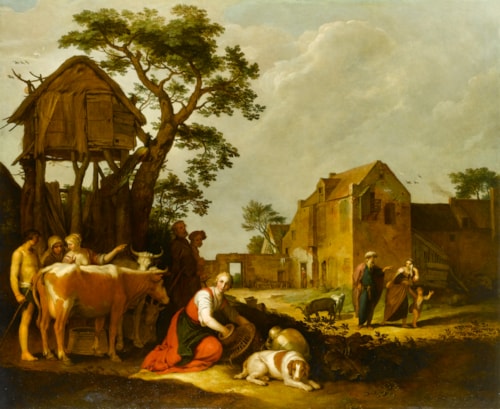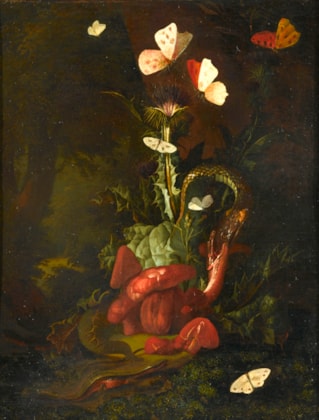panish School, c.1529
Christ Washing the Disciples Feet
indistinctly dated ‘1529 ...19’ (lower right)
oil on panel
45.7 x 75 cm (18 x 29½ in)
The subject matter of this work relates to the preparations for Passover (The Last Supper) and, in the Gospels, only John records these events. In Jesus’ time, it was customary for people to have the dust washed off their feet before entering a house. It normally fell to the incumbent servants to perform such a lowly task. Here, however, Jesus himself washes the disciples’ feet in order to teach them to serve one another just as he has served them. The positioning of the twelve disciples, with the group on his left mostly standing, and those on his right reclining above him, acutely emphasise the lowliness of his position.
With a gleaming copper basin brimming with water and ‘with the towel wherewith he was girded’, Jesus thus prepared them for priesthood. Only one of his twelve disciples, Simon Peter, perhaps pictured seated in a blue robe, protested at his master carrying out such an act. In reply, Jesus told him: ‘If I wash thee not, thou hast no part of me’. Peter then said, ‘Lord, not my feet only, but also my hands and my head’.¹ Jesus then contradicts him and, addressing him personally, adds: ‘... you are clean, though not all of you ...’ hinting at the imminent betrayal of Judas Iscariot, who is pictured here clutching a bag of money.
Judas, the archetypal betrayer, is depicted with a bag of money which could be in reference to the following event: when the Jewish chief priests and elders were plotting to have Jesus arrested and put to death, Judas asked them what they would give him to betray Jesus. They promptly offered Judas thirty pieces of silver. Here he is holding either that promised silver or the disciples’ money, of which he was the treasurer. Judas is often accompanied by a demon, or some other creature, and it is possible that the little cat detailed by his feet alludes to this.
Renaissance Spain never developed secular imagery on the scale seen in Italy, as princely patrons were more interested in funding military ventures than in commissioning art. From the marriage of Isabella of Castile and Ferdinand of Aragon in 1469 onwards, the subject matter of Spanish art was overwhelmingly Catholic. Particularly during the siglo de oro or Golden Age from the reign of their grandson Charles I (1516 - 1556) to the end of the Habsburg dynasty in 1700, Spanish art continued in this vein.
¹ John 13:9
The subject matter of this work relates to the preparations for Passover (The Last Supper) and, in the Gospels, only John records these events. In Jesus’ time, it was customary for people to have the dust washed off their feet before entering a house. It normally fell to the incumbent servants to perform such a lowly task. Here, however, Jesus himself washes the disciples’ feet in order to teach them to serve one another just as he has served them. The positioning of the twelve disciples, with the group on his left mostly standing, and those on his right reclining above him, acutely emphasise the lowliness of his position.
With a gleaming copper basin brimming with water and ‘with the towel wherewith he was girded’, Jesus thus prepared them for priesthood. Only one of his twelve disciples, Simon Peter, perhaps pictured seated in a blue robe, protested at his master carrying out such an act. In reply, Jesus told him: ‘If I wash thee not, thou hast no part of me’. Peter then said, ‘Lord, not my feet only, but also my hands and my head’.¹ Jesus then contradicts him and, addressing him personally, adds: ‘... you are clean, though not all of you ...’ hinting at the imminent betrayal of Judas Iscariot, who is pictured here clutching a bag of money.
Judas, the archetypal betrayer, is depicted with a bag of money which could be in reference to the following event: when the Jewish chief priests and elders were plotting to have Jesus arrested and put to death, Judas asked them what they would give him to betray Jesus. They promptly offered Judas thirty pieces of silver. Here he is holding either that promised silver or the disciples’ money, of which he was the treasurer. Judas is often accompanied by a demon, or some other creature, and it is possible that the little cat detailed by his feet alludes to this.
Renaissance Spain never developed secular imagery on the scale seen in Italy, as princely patrons were more interested in funding military ventures than in commissioning art. From the marriage of Isabella of Castile and Ferdinand of Aragon in 1469 onwards, the subject matter of Spanish art was overwhelmingly Catholic. Particularly during the siglo de oro or Golden Age from the reign of their grandson Charles I (1516 - 1556) to the end of the Habsburg dynasty in 1700, Spanish art continued in this vein.
¹ John 13:9





 contact
contact contact
contact +44 20 7313 8040
+44 20 7313 8040









